Drone photography can revolutionize your architectural modeling by offering breathtaking aerial perspectives. You'll capture high-resolution images and videos that showcase design elements and spatial relationships from unique angles. To get started, choose a drone with a high-quality camera and advanced stabilization. Plan your shoots carefully, considering weather, lighting, and local regulations. Master flight techniques to achieve smooth, professional-looking footage. Integrate these aerial shots into your 3D models and presentations to provide context and create immersive experiences. With practice and creativity, you'll elevate your architectural visualizations to new heights. The sky's the limit for what you can achieve with this innovative approach.
Understanding Drone Photography for Architecture
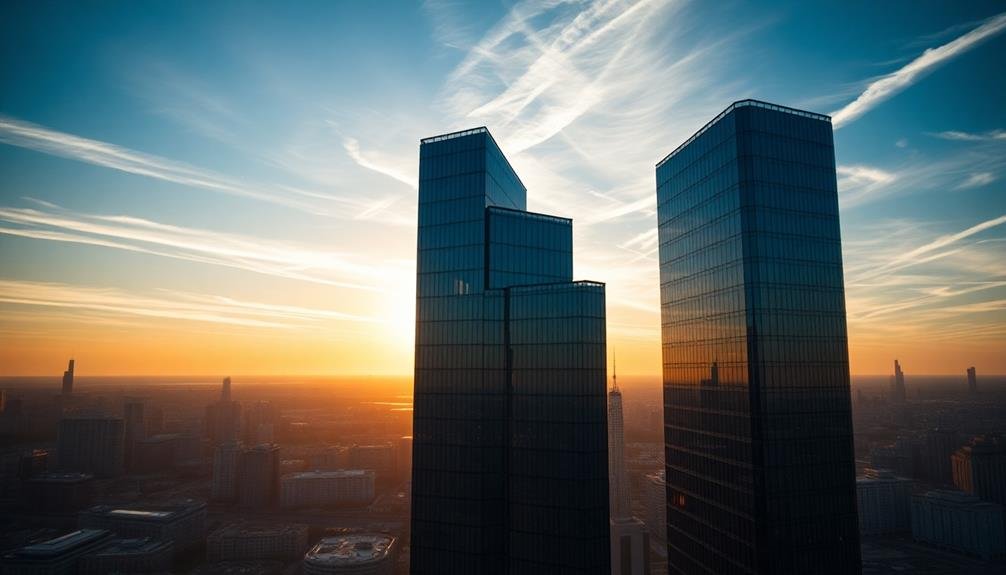
Soaring above traditional methods, drone photography has revolutionized architectural modeling. You'll find that drones offer unparalleled access to perspectives once difficult or impossible to capture. They provide a bird's-eye view of structures, allowing you to showcase buildings in their entirety and within their surrounding context.
To effectively use drone photography for architecture, you'll need to understand its unique capabilities. Drones can capture high-resolution images and videos from various angles and heights, giving you flexibility in your architectural presentations. You'll be able to highlight specific design elements, reveal spatial relationships, and demonstrate how a building interacts with its environment.
However, you must also be aware of the challenges. Weather conditions, flight regulations, and privacy concerns can impact your drone operations. You'll need to obtain necessary permits and adhere to local laws. Additionally, mastering drone controls and camera settings is essential for achieving professional results.
When planning your shoot, consider the time of day, lighting conditions, and the building's orientation. You'll want to capture the structure at its best, emphasizing its most striking features and design innovations.
Choosing the Right Drone Equipment
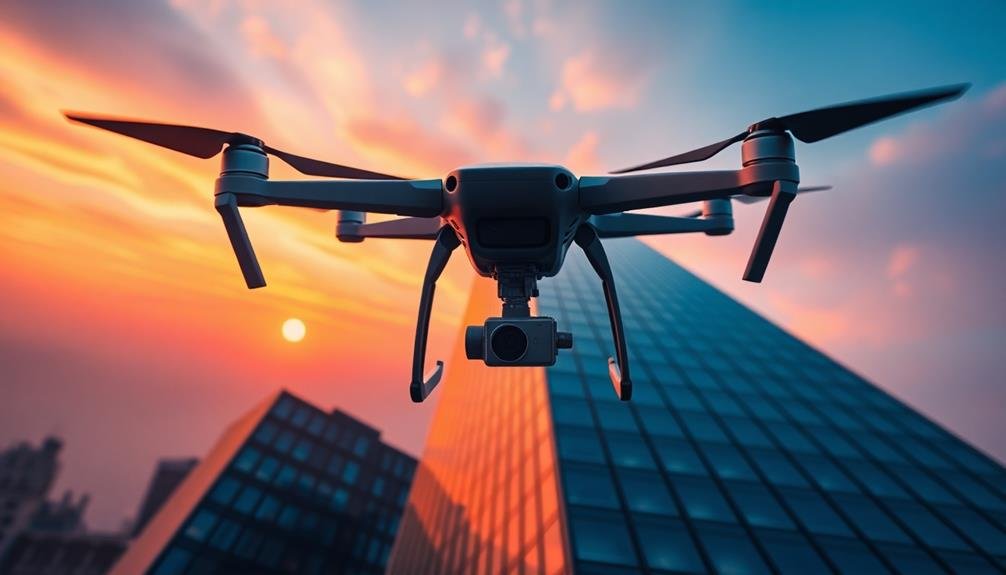
With drone photography's potential in mind, let's focus on selecting the right equipment for architectural modeling. You'll need to take into account several factors to guarantee you capture high-quality aerial images for your projects.
First, choose a drone with a high-resolution camera, ideally 20MP or more, to capture detailed shots of buildings and landscapes. Look for models with adjustable camera settings, allowing you to control exposure, ISO, and shutter speed. Stability is vital, so opt for drones with advanced gimbal systems and obstacle avoidance technology.
Think about these key features when selecting your drone equipment:
| Feature | Entry-Level | Professional |
|---|---|---|
| Camera Resolution | 12MP | 20MP+ |
| Flight Time | 20-25 mins | 30+ mins |
| Obstacle Avoidance | Basic | Advanced |
| Transmission Range | 2-3 km | 5+ km |
Don't forget essential accessories like extra batteries, propellers, and memory cards. A rugged carrying case will protect your investment during transport. Finally, make sure you're familiar with local drone regulations and obtain necessary permits before flying in urban areas or near buildings.
Planning Your Aerial Shoot
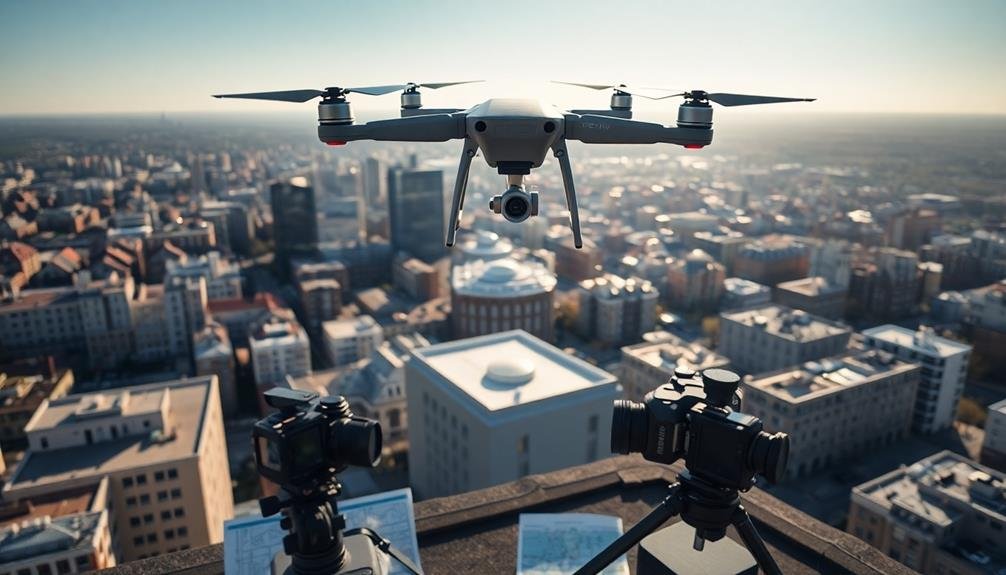
Before you take flight, carefully consider the weather conditions for your architectural shoot.
You'll want clear skies and minimal wind to capture crisp, stable images of the structure.
Scout potential shooting locations in advance, looking for vantage points that showcase the building's most striking features and allow for unobstructed views.
Choose Optimal Weather Conditions
Weather conditions play an important role in the success of your aerial architectural shoot. You'll want to select a day with clear skies and minimal cloud cover to guarantee the best lighting and visibility. Aim for early morning or late afternoon hours when the sun is lower in the sky, creating dramatic shadows and highlighting architectural details.
Wind speed is vital; choose a day with calm conditions to prevent camera shake and guarantee stable footage. Ideally, wind speeds should be below 10 mph for most drones. Avoid days with high humidity or fog, as these can create haze and reduce image clarity.
Consider the season and how it affects the surrounding landscape. Spring and fall often provide vibrant colors that can enhance your architectural shots.
If you're shooting in an urban environment, be mindful of smog levels and try to schedule your shoot after a light rain when the air is clearer.
Always check local weather forecasts and aviation weather reports before your shoot. Remember to have a backup date in case conditions aren't ideal on your planned day.
Scout Ideal Shooting Locations
Scouting ideal shooting locations is a crucial step in planning your aerial architectural shoot. You'll need to identify spots that showcase the building's best features while guaranteeing safety and legal compliance.
Start by researching the area using satellite imagery and maps to get a sense of the terrain and potential obstacles. Then, visit the site in person to assess lighting conditions, background elements, and possible takeoff and landing zones.
Consider these factors when scouting locations:
- Elevation changes that can add depth to your shots
- Natural or urban elements that frame the structure
- Angles that highlight unique architectural features
- Vantage points that capture the building's relationship to its surroundings
Once you've identified promising locations, check for any airspace restrictions or required permits. Contact local authorities if necessary to guarantee you're following all regulations.
Don't forget to account for the time of day and how it affects lighting and shadows on the building. Plan multiple shooting positions to capture a variety of perspectives, and mark them on a map for easy reference during the actual shoot.
Mastering Drone Flight Techniques
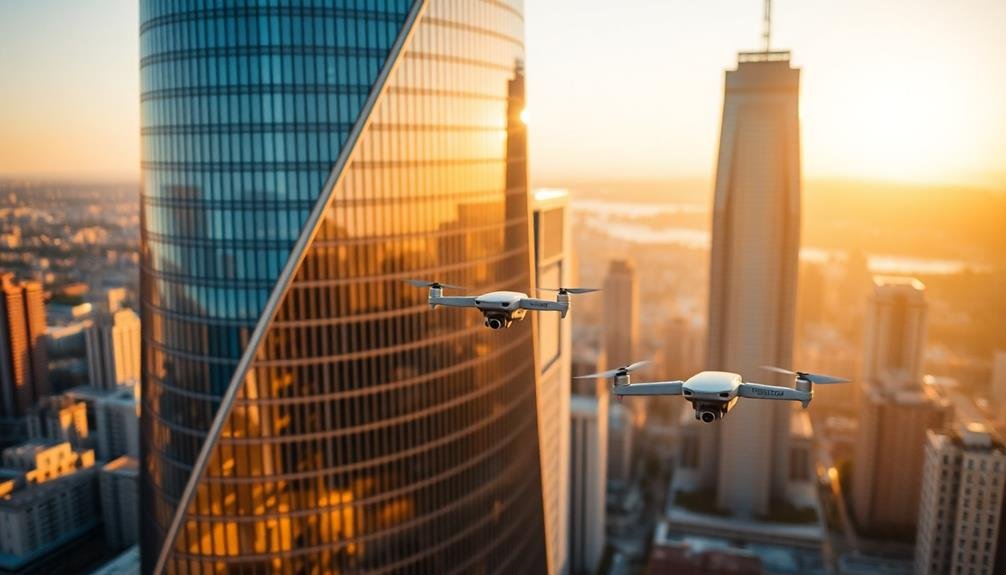
A drone pilot's proficiency in flight techniques is essential for capturing stunning architectural imagery. You'll need to master various flight patterns to showcase buildings from their best angles. Start with basic maneuvers like hovering, ascending, and descending smoothly.
Practice flying in straight lines and executing precise turns to maintain control over your shots. Learn to perform more advanced techniques such as orbiting, where you circle the structure while keeping it centered in your frame.
Master the art of reveal shots by starting low and slowly ascending to dramatically disclose the building. Experiment with dolly zooms, combining forward movement with lens zooming for a unique perspective.
Pay attention to your drone's speed and acceleration. Smooth, slow movements often yield the best results for architectural photography. Utilize intelligent flight modes like waypoints or point of interest to create consistent, repeatable flight paths.
Don't forget to reflect on wind conditions and obstacle avoidance when planning your flights. Regularly practice these techniques in safe environments before attempting them on actual projects.
With dedication and experience, you'll develop the skills necessary to capture breathtaking aerial views of architectural marvels.
Capturing Stunning Architectural Perspectives
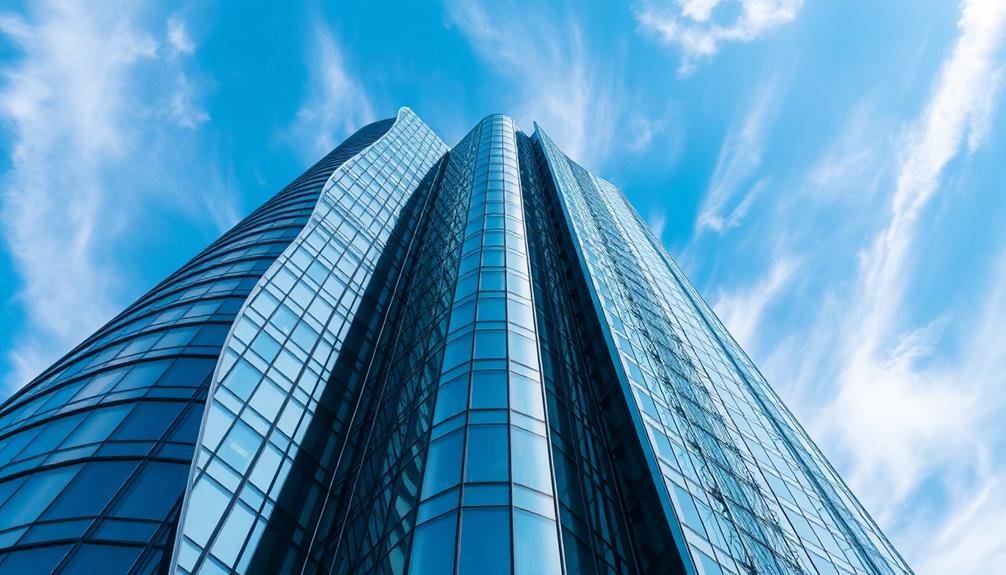
You'll discover numerous advantages when using drones for architectural photography, including the ability to capture expansive views and intricate details from previously inaccessible angles.
By experimenting with unique perspectives and compositions, you can showcase a building's relationship with its surroundings and highlight its most striking features.
Don't forget to take into account weather conditions and lighting when planning your shoots, as these factors can dramatically impact the mood and quality of your architectural images.
Drone Photography Advantages
With drone photography, you can capture breathtaking aerial views of architectural marvels that were once impossible to achieve. Drones offer unparalleled flexibility, allowing you to showcase buildings from unique angles and heights.
You'll be able to highlight intricate rooflines, expansive landscapes, and the interplay between structures and their surroundings.
Drones provide cost-effective solutions for capturing high-quality aerial shots without the need for expensive helicopters or cranes. You can easily maneuver them into tight spaces, revealing hidden architectural details that ground-based photography might miss.
With advanced stabilization technology, you'll produce smooth, professional-looking footage that adds dynamism to your architectural presentations.
Here's what you can achieve with drone photography:
- Sweeping panoramas of entire building complexes
- Bird's-eye views of intricate courtyard designs
- Dynamic fly-through shots that showcase a building's scale
- Revealing angles of hard-to-reach architectural features
Unique Angles and Compositions
Mastering unique angles and compositions is essential for capturing stunning architectural perspectives. With drone photography, you'll reveal a whole new dimension of creative possibilities. You can now easily capture bird's-eye views, revealing the intricate patterns and symmetry of building layouts that aren't visible from the ground.
Experiment with different altitudes to showcase the interplay between a structure and its surroundings. Low-altitude shots can emphasize the building's imposing presence, while higher altitudes provide context within the urban landscape.
Don't shy away from unconventional angles – tilt your drone to capture dynamic diagonal lines or spiral around a tower for a dizzying effect.
Leverage natural light to your advantage. Golden hour can cast long shadows, adding depth and drama to your compositions. Capture reflections in glass facades or nearby bodies of water for striking symmetry.
Play with scale by juxtaposing architectural elements against people or vehicles.
Remember to reflect on negative space in your compositions. Sometimes, what you leave out of the frame is just as important as what you include.
Weather and Lighting Considerations
Weather and lighting conditions play an essential role in capturing stunning architectural perspectives. They can transform a building's appearance, creating dramatic shadows, highlighting textures, and emphasizing architectural features.
To elevate your architectural photography, you'll need to take into account the time of day, season, and weather patterns that best complement your subject.
Golden hour, just after sunrise or before sunset, often provides warm, soft light that flatters most structures. However, don't overlook the potential of overcast days, which can create even lighting and reduce harsh shadows.
Rainy conditions can add reflections and a moody atmosphere, while snow can simplify compositions and add a serene quality to your images.
To create engaging architectural imagery, take note of these elements:
- Sunbeams piercing through clouds, casting dramatic rays across a building's facade
- Fog rolling in, partially obscuring a skyscraper's upper floors for a mystical effect
- Rain-slicked streets reflecting colorful neon signs on a bustling city block
- A fresh blanket of snow contrasting against the stark lines of a modern structure
Post-Processing Aerial Imagery
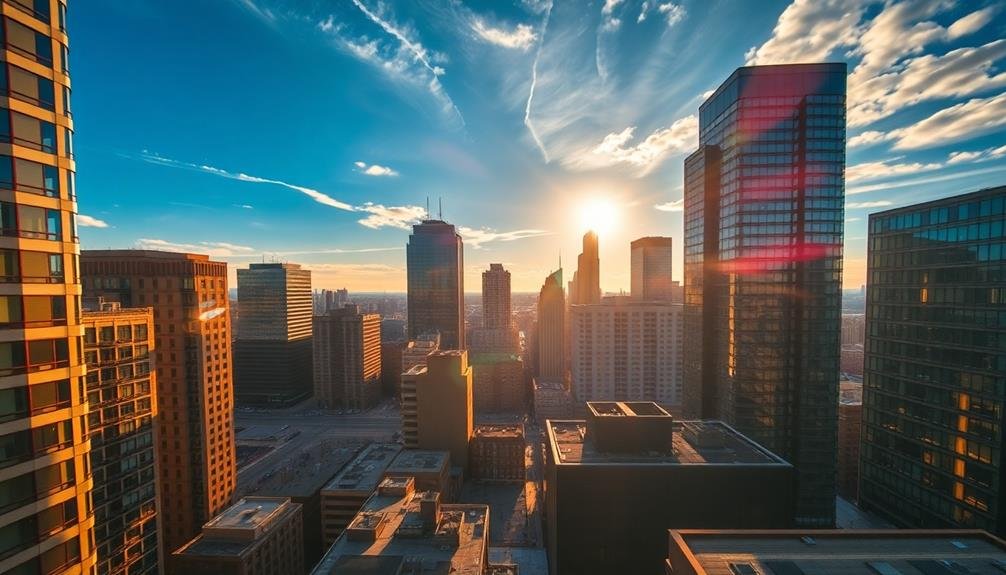
Post-processing aerial imagery kicks off the transformation of raw data into valuable architectural insights. Once you've captured your aerial shots, it's time to refine them for optimal use in your architectural modeling process.
Start by importing your images into photo editing software like Adobe Lightroom or Capture One.
Begin with color correction, adjusting white balance to guarantee accurate representation of materials and surfaces. Next, fine-tune exposure and contrast to bring out architectural details. Pay special attention to shadows and highlights, as these can reveal essential information about building structures and site topography.
Apply lens corrections to remove distortions and chromatic aberrations, assuring your images are as geometrically accurate as possible. If you're working with multiple images, consider stitching them together to create high-resolution panoramas or orthomosaics.
For 3D modeling purposes, you'll want to enhance edge detection and sharpen key features. Use selective adjustments to emphasize important architectural elements while reducing noise in less critical areas.
Integrating Drone Shots Into 3D Models
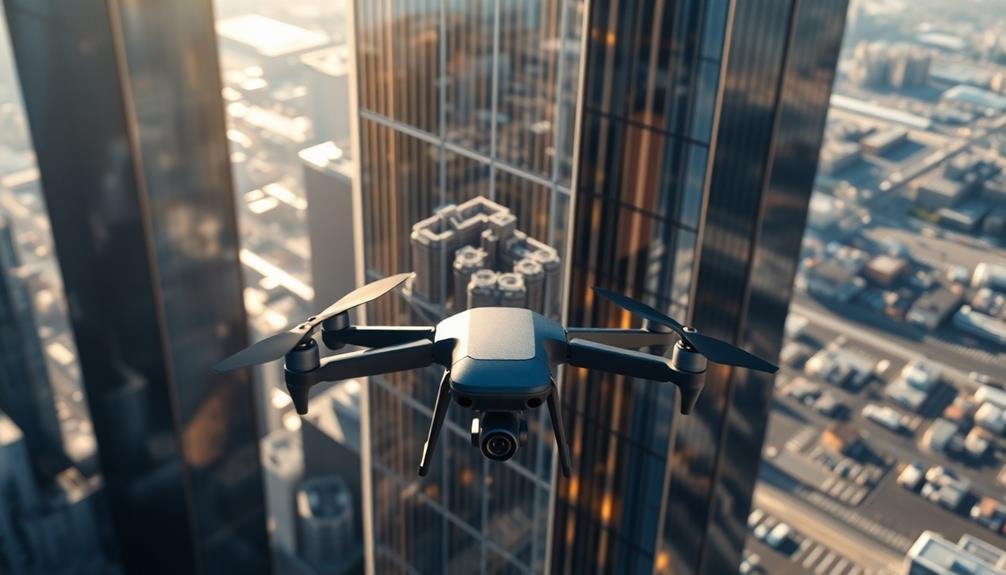
With your aerial imagery processed, it's time to seamlessly integrate drone shots into your 3D architectural models.
Begin by aligning your drone imagery with your existing 3D model using common reference points. You'll need to match the camera angles and positions from your drone shots to the virtual camera in your 3D software. This process, known as camera matching, guarantees that your aerial photos line up perfectly with your digital model.
Next, use your drone imagery as texture maps or background plates in your 3D environment. This adds a layer of realism to your architectural visualizations, allowing you to showcase your designs in their actual context.
Don't forget to adjust lighting and atmospheric conditions in your 3D model to match those in your drone shots for a cohesive final result.
- A sleek skyscraper emerging from a bustling cityscape
- A modern home nestled in a lush forest clearing
- A sprawling industrial complex along a winding river
- A futuristic sports stadium rising above a sea of parking lots
Enhancing Presentations With Aerial Views
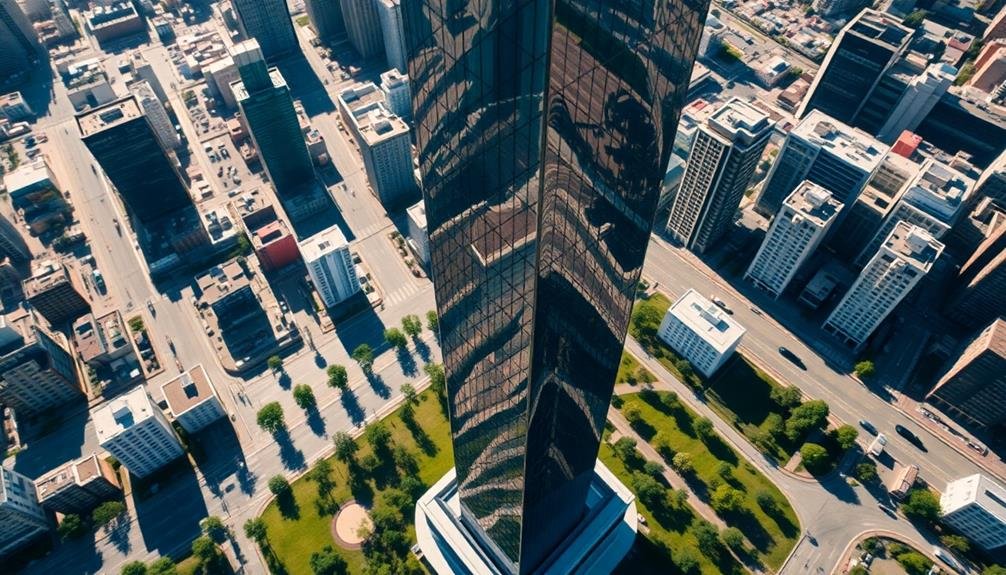
Aerial views captured by drones can dramatically enhance your architectural presentations. These bird's-eye perspectives offer a unique way to showcase your projects, providing context and scale that ground-level images can't match.
You'll be able to highlight how your design fits into its surroundings, emphasizing its relationship with nearby structures and landscapes.
When incorporating aerial views, consider using them to create a narrative flow in your presentation. Start with wide shots that establish the project's location, then gradually zoom in to reveal more detailed aspects of your design. This approach helps your audience understand the project's scope and impact.
Don't limit yourself to static images. Drone footage can add dynamic elements to your presentation, allowing you to create virtual fly-throughs that simulate the experience of approaching and exploring the site.
Use these aerial perspectives to emphasize key features, such as green spaces, traffic flow, or sustainable design elements that mightn't be apparent from ground level.
Remember to balance aerial views with other visuals. While they're powerful tools, they should complement, not overshadow, your detailed renderings and floor plans.
Overcoming Aerial Photography Challenges
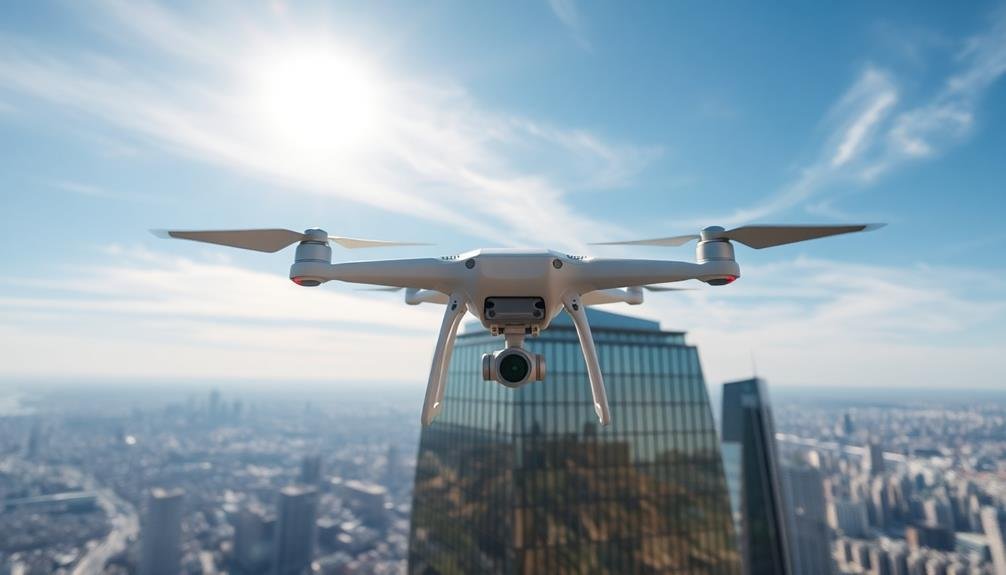
Challenges abound when it comes to aerial photography for architectural modeling. You'll need to navigate legal restrictions, weather conditions, and technical limitations to capture stunning sky-high shots. Obtaining necessary permits and adhering to local regulations is essential before you even begin.
Once airborne, you'll face unpredictable elements like wind and changing light conditions that can affect image quality.
To overcome these hurdles, consider these strategies:
- Use drones equipped with stabilization technology for smoother footage
- Schedule shoots during ideal lighting conditions, typically early morning or late afternoon
- Invest in high-quality lenses with adjustable focal lengths for versatility
- Employ post-processing techniques to enhance image clarity and color accuracy
Mastering aerial photography takes practice and patience. You'll need to develop a keen eye for composition while managing your equipment in challenging environments.
Focus on capturing multiple angles and perspectives to provide a thorough view of the architectural project. By anticipating potential obstacles and preparing accordingly, you can elevate your architectural modeling with breathtaking aerial imagery that showcases designs in their full context and grandeur.
Legal Considerations for Drone Usage
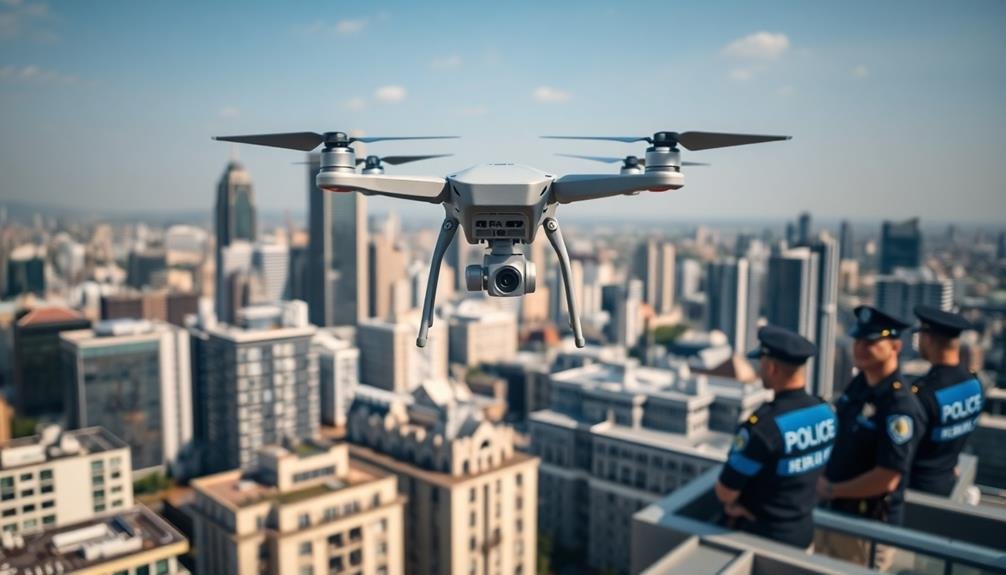
When using drones for architectural modeling, you'll need to navigate a complex web of legal requirements.
You must register your drone and obtain proper certifications, as mandated by aviation authorities.
Additionally, you'll have to adhere to privacy laws and airspace regulations, which vary by location and can impact where and how you operate your drone.
Registration and Certification Requirements
Drone pilots must navigate a complex web of registration and certification requirements before taking flight for architectural modeling.
In the United States, you'll need to register your drone with the Federal Aviation Administration (FAA) if it weighs more than 0.55 pounds. For commercial use, you'll also need to obtain a Remote Pilot Certificate by passing the FAA's Part 107 exam.
To legally operate your drone for architectural photography, you must:
- Fly below 400 feet above ground level
- Keep your drone within visual line of sight
- Avoid flying over people or moving vehicles
- Respect airspace restrictions and no-fly zones
Remember that local laws may impose additional restrictions. Some cities require permits for commercial drone operations, while others prohibit drone use entirely in certain areas.
It's essential to research and comply with all applicable regulations in your specific location.
Stay current with evolving drone laws, as they can change rapidly. Joining professional organizations or online communities can help you stay informed about new requirements and best practices.
Privacy and Airspace Regulations
Maneuvering the complex landscape of privacy and airspace regulations is essential for drone operators in architectural modeling. You'll need to familiarize yourself with local, state, and federal laws governing drone usage. The FAA's Part 107 rules outline general operating guidelines, including flying below 400 feet and maintaining visual line of sight.
Be aware of restricted airspace, such as airports, military bases, and national parks. Always check for temporary flight restrictions before each flight. Respect privacy laws by avoiding capturing images of people or private property without consent.
When photographing buildings, consider the potential for inadvertently capturing sensitive information through windows or open spaces. You must also adhere to property rights laws. Don't fly over private property without permission, and be cautious when operating near public spaces.
Some cities have additional drone regulations, so research local ordinances before flying. Remember that violating these rules can result in hefty fines or legal consequences.
Stay updated on changing regulations, as drone laws evolve rapidly. Join professional organizations to access resources and stay informed about industry best practices and legal developments in drone operation for architectural modeling.
Future Trends in Architectural Drone Photography
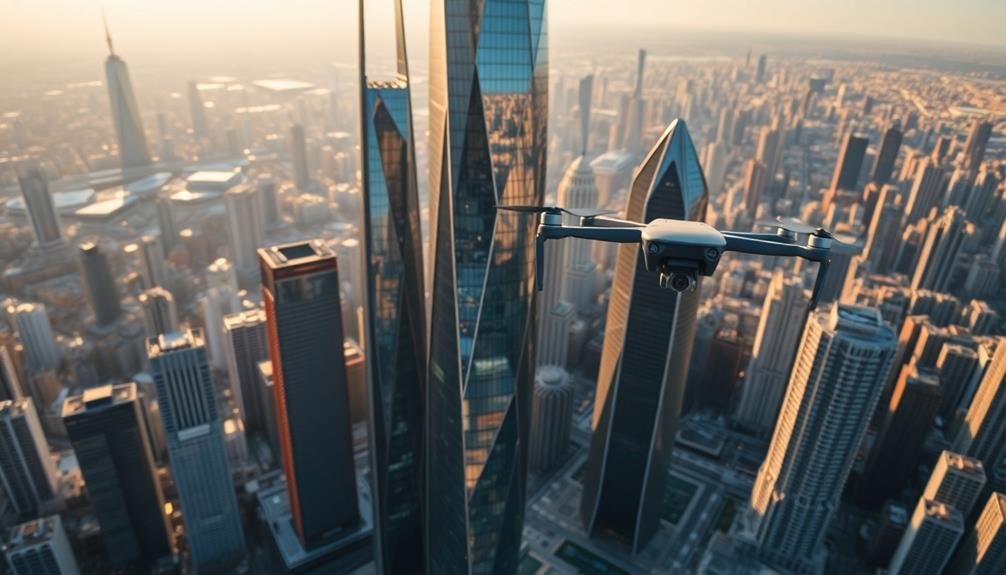
On the horizon of architectural visualization, drone photography is poised to revolutionize the way we capture and present buildings. As technology advances, you'll see drones equipped with higher-resolution cameras, capable of capturing intricate details and textures.
AI-powered flight paths will enable more precise and repeatable shots, ensuring consistency across multiple visits to a site. You can expect to see an increase in thermal imaging capabilities, allowing architects to assess energy efficiency and identify potential structural issues.
Virtual reality integration will transform how you experience architectural models, offering immersive walkthroughs of buildings before they're constructed.
Future trends in architectural drone photography will likely include:
- 360-degree cameras for seamless panoramic views
- LiDAR sensors for accurate 3D mapping and modeling
- Real-time data transmission for instant collaboration
- Autonomous swarm drones for large-scale projects
As regulations evolve, you'll have more freedom to explore creative angles and perspectives. Night photography will become more prevalent, showcasing buildings in dramatic lighting conditions.
With advancements in battery technology, drones will have longer flight times, allowing for more thorough documentation of large-scale projects. These innovations will fundamentally change how you visualize, present, and market architectural designs.
Frequently Asked Questions
How Does Weather Affect Drone Battery Life During Architectural Photography Shoots?
You'll find that weather notably impacts your drone's battery life. Cold temperatures decrease capacity, while wind forces your drone to work harder. Hot conditions can overheat batteries. Rain and humidity pose risks, so you'll need to plan accordingly.
Can Drones Be Used for Interior Architectural Photography?
Yes, you can use drones for interior architectural photography. They're great for capturing high ceilings, large spaces, and unique angles. However, you'll need to take into account lighting, obstacles, and local regulations when flying indoors. Practice is key for success.
What Insurance Considerations Are Necessary for Professional Architectural Drone Photography?
You'll need liability insurance to cover potential damage or injuries. Consider drone-specific policies that protect your equipment and operations. Don't forget to check if your existing business insurance covers drone use for professional photography.
How Do Different Building Materials Impact Drone Photography Results?
You'll find that reflective materials like glass and metal can create glare, while darker materials may absorb light. Textured surfaces add depth, but smooth ones might appear flat. Consider the time of day for ideal lighting on different materials.
Are There Specific Drone Models Designed Exclusively for Architectural Photography?
While there aren't drones exclusively for architectural photography, you'll find models like the DJI Phantom 4 Pro and Mavic 2 Pro are popular choices. They offer high-resolution cameras, obstacle avoidance, and stability features ideal for capturing buildings.
In Summary
You've now got the tools to take your architectural modeling to new heights. By embracing drone photography, you'll capture stunning aerial perspectives that elevate your presentations. Remember to plan carefully, master your flight techniques, and stay informed about legal requirements. As technology advances, you'll find even more exciting ways to showcase your designs from above. So go ahead, launch your drone, and let your architectural visions soar!

As educators and advocates for responsible drone use, we’re committed to sharing our knowledge and expertise with aspiring aerial photographers.




Leave a Reply